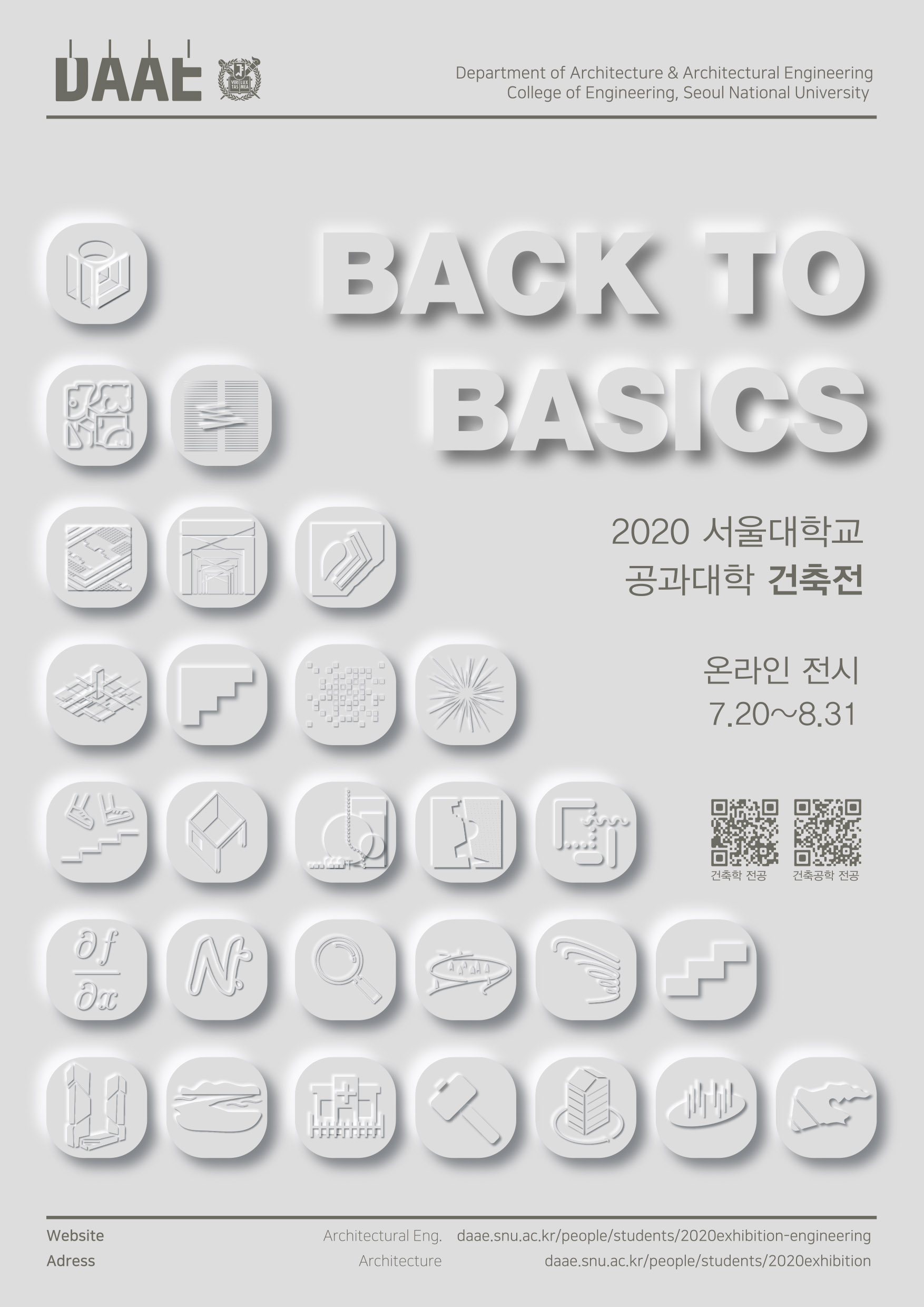다시 기본으로
Back to Basics

서울대학교 건축학과 졸전 2020
근래 들어 우리 사회에 근본 주의적인 사고가 급격히 퍼지고 있다. 다면적인 상황이 흑백 논리의 틀을 거쳐 국경 봉쇄와 정치의 양극화, 그리고 최악의 경우에는 극단적인 폭력으로 연결되는 ‘트위터 선언문’과 같은 표현으로 단순화된다.
한편 건축은 태생적으로 복합적이다. 건축은 땅과 역사, 사람들과 관련을 맺는다. 근본주의는 승승장구하는 반면, 미묘한 우연성을 다루는 건축은 설 곳을 잃은 것만 같다. 한 쪽에 치우친 극단주의자들과 싸워야 할 때, 다양성에 근거한 건축가들은 그들의 이론/생각을 한 방의 잽으로 만들어 싸울 수 있을까?
‘기본으로 돌아가기(back to basics)’는 “건축이란 무엇인가”라는 질문에 대한 자기 성찰이다. 이 질문이야 말로 참으로 원초적이고 환원적이며 이데올로기적이다. 또 건축의 미래에 대한 불안감이 투영돼 있기도 하다. 건축은 어떤 사회적 역할을 해야 하는가? 중요한 세 가지 텍스트의 틀내에서 탐구를 시작한다.
건축은 요소의 총합에 불과한가? 2014년 베니스 비엔날레에서 총 감독인 렘 쿨하스(Rem Koolhaas)는 건축이 요소(Architectural Elements)로 환원된다고 선언했다. 벽과 천장, 창과 기계적 장치들 모두 파편적으로 존재하며 이들 간의 건축적인 조화는 신화일 뿐이라고 주장한다.
건축은 유형으로 작동하는가? 라파엘 모네오(Rafael Moneo)는 오래가는 유형들이 쓰임과 형태의 연결을 통해 작동한다고 주장한다. 건축가의 궁극적인 기여는 일반적인 건축 유형을 발명함으로써, 작가로서의 개별성을 넘어서 익명성을 획득하는 것이다.
건축은 언어로 작동하는가? 알도 로씨(Aldo Rossi)는 마치 언어처럼 도시의 요소들 또한 기표와 기의로 구성된다고 주장한다. 작가의 글이 그러하 듯 건축의 드로잉은 현실의 재현물에 그치지 않고 그 자체로 자율적인 무언가로 작동한다.
'기본으로 돌아가기'는 지난 4년 간의 배움을 각자 하나의 건축적 가설로 환원해보는 작업이다. (변해가는 사회 속에서) 건축에 여전히 기본적인 무언가 있다는 지난 시절의 반짝이던 믿음을 유지할 수 있을까? 우리가 세운 원칙들이 터무니없는 것일지라도, 우리는 이것을 구명보트 삼아 앞으로의 항해를 준비할 것이다.
졸업 전시 평가위원 명단
외국인
Peter Winston Ferretto
Tel: +852 3943 6560
Mobile: +852 9853 1535
E-mail: peter.ferretto@cuhk.edu.hk
소속: The Chinese University of Hong Kong (Associate Professor)
Erik G. L'Heureux
Tel: +65 9129 0428 / +65 6516 3477
E-mail: elheureux@gmail.com / akierik@nus.edu.sg / erik@penciloffice.com
소속: National University of Singapore
내국인
임동우
Mobile: 010 9195 1226
E-mail: dyim@praud.info
소속: 홍익대학교 건축학과
임미정
Mobile: 010 2716 1397
E-mail: mj@stpmj.com
소속: 건축사사무소 stpmj
SNU Studio 5-1 2020
We have recently seen a dramatic rise in fundamentalist thinking: Painted in black and white, multifaceted situations are reduced into ‘twitter manifestoes’ conjuring closed borders, polarized politics, and in the worst-case, extremist violence.
Architecture on the other hand is inherently complex, linked to sites, histories, and peoples. If fundamentalism is winning, architecture with all its nuanced contingencies is losing: As a profession, we are increasingly ill-equipped to reduce our theories into sound-bites. Therefore, our ideas, grounded in diversity, cannot ‘battle’ one-sided reductive thinking. Or can they?
‘Back to Basics’ is a self-conscious inquiry into the question, ‘What is Architecture?’ The question is raw, reductive, and ideological. It is also layered with insecurities about architecture’s future. What societal roles should it play? To get us started, we looked at the questions within 3 essential texts:
1. Is Architecture Elements? At the 2014 Venice Biennale, curator Rem Koolhaas stated that architecture is merely elements. Walls, ceilings, windows, and mechanical equipment are all fragments, and their reconciliation is a myth.
2. Is Architecture Typology? Rafael Moneo claimed enduring types communicate their use through form. An architect’s ultimate contribution is to invent a type so general that his/her work becomes anonymous.
3. Is Architecture Language? Aldo Rossi posits that a city’s elements, like language, are signs and symbols. Drawing itself is like writing: It is no longer a representation of reality, but an autonomous act in of itself.
Culminating our previous 4 years of architectural studies, ‘Back to Basics’ takes what we learned and hones it into a reductive thesis. Even if our principles border on the absurd, we will stick to them like a lifeboat. Because without these fundamentals, we might forever lose that distant sparkle of a time when we used to believe in something.